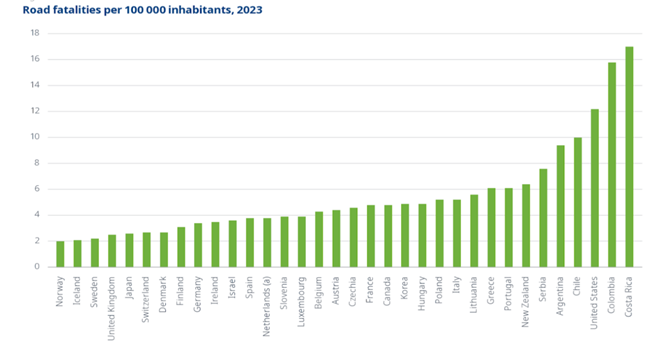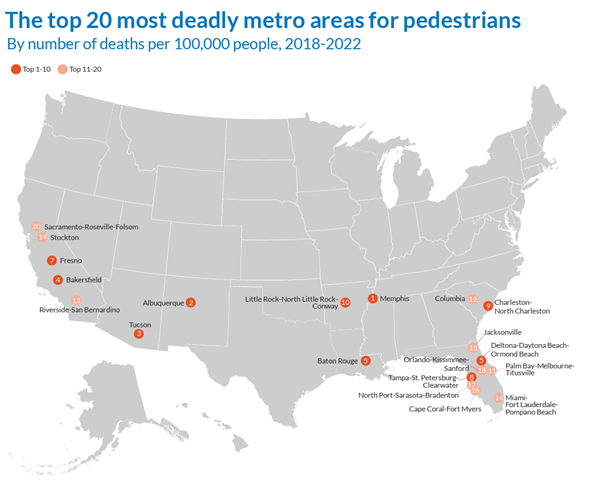Blog written by Philip Plotch. Originally posted here by Eno Center for Transportation and reposted here with permission. The webinar recording are slides are available here.
At a recent Eno webinar, three leading advocates for transportation safety, walking and transit — Beth Osborne, Ward McCarragher, and Mike McGinn — shared their insights about shifting federal transportation policies. They also answered questions from roughly 400 attendees about how their organizations are shaping the ongoing Congressional debate over reauthorizing the five-year surface transportation law. The Infrastructure Investment and Jobs Act (IIJA) expires on September 30 next year.
In the months ahead, Eno will continue to provide a broad range of perspectives on these matters.
Beth Osborne, President and CEO of Smart Growth America
Beth Osborne is the president and CEO of Smart Growth America, an organization that promotes the development of healthy, prosperous, and resilient communities. Its subsidiary, Transportation for America, focuses on creating a transportation system that connects people to jobs and essential services “no matter how they travel, no matter how much money they make, and no matter their physical abilities.”
Osborne presented a chart comparing roadway fatality rates across the globe. She described how the rate is higher in the U.S. than most developed countries and even many developing countries, such Mexico and Chile. She called this inexcusable for “a nation as wealthy and technologically sophisticated as ours.”

Pointing to the graph below, she noted how regions in the U.S. with the highest fatality rates are the ones where most of the residential and commercial uses have been built around highways rather than sidewalks and transit lines.

Osborne cited the American Society of Civil Engineers (ASCE) infrastructure report card, which gives the U.S. a “C” grade. Our nation, she said, is falling behind in terms of repair: “In the past two decades, we put record amounts of money into addressing our crumbling roads and bridges and we’ve made no improvement.” One major reason for this failure, she argued, is the misguided focus on building new highway lanes in an attempt to reduce congestion—an approach that has only worsened congestion in the long run.
Regarding the upcoming reauthorization of the federal surface transportation law, Osborne was unequivocal: “We want massive changes or a rollback of the program.” She emphasized that her top priorities are a “fix-it-first” approach and a system that requires measurable safety improvements and holds everyone accountable for results.
Ward McCarragher, Vice President at the American Public Transportation Association
Ward W. McCarragher is a vice president at the American Public Transportation Association (APTA). His 1,700 member organization represents all sectors of the transit industry including operators, manufacturers, suppliers, engineers, labor unions, and construction firms.
Unlike Transportation for America, McCarragher said that APTA strongly supports continuing to fund and expand existing transportation programs because the federal government is “a critical partner from the smallest agency in rural Montana to the Gateway Development Commission constructing the Hudson Tunnel.”
Specifically, APTA wants Congress to build upon the public transit and passenger rail investments in IIJA and restore the purchasing power lost to inflation since its enactment in 2021. Under APTA’s reauthorization proposal, federal transit funding would increase from $22 billion in FY 2026 to $29 billion in FY 2031. Over five years, the program would expand from $108 billion to $138 billion—a $30 billion increase, or 27% growth over the IIJA baseline.
In addition to increased funding, APTA is proposing a wide range of policy reforms. McCarragher highlighted four key areas:
- Streamline statutory and regulatory requirements, such as the Capital Investment Grant program process and bus spare ratio requirement rule.
- Return decision-making power to transit CEOs regarding the development and implementation of safety plans.
- Ensure public transit representation on Metropolitan Planning Organizations (MPOs).
- Accelerate project delivery and permitting reform.
Mike McGinn, Executive Director at America Walks
Mike McGinn, executive director of America Walks, brought a local perspective to the national transportation conversation. A former mayor of Seattle, McGinn recalled contentious debates over highway expansions, bike lanes, and bus lanes—experiences that now inform his national advocacy.
America Walks focuses on supporting local advocacy because, as McGinn emphasized, “So much of the work on transportation—and most of the money—is raised and spent at the local and especially the state level.” His organization trains and educates local advocates while also running national campaigns, such as the recent “Week Without Driving”, which garnered national media attention and engaged people across the country in thinking differently about mobility.
McGinn challenged the notion that walkability is solely about sidewalk funding: “What creates a walkable place isn’t just the physical street infrastructure. It’s about the kind of places we build—places where destinations, homes, businesses, and jobs are near each other. And transportation policy has a huge effect on that.”
He said surveys show that the public wants to prioritize repairing existing roads, increasing transit options, and building communities where people don’t have to drive as much. “So why,” he asked, “do we have a policy that’s so at odds with public opinion?”
Part of the answer, McGinn argued, lies in entrenched interests. Construction companies and labor unions who benefit from billions of dollars in highway contracts influence transportation agency officials and play a powerful role in electoral politics. “They have the ear of elected officials. And even with public opinion on our side, we still find ourselves not doing so great.”
Lack of Trust in D.C.
When asked about the short and long-term impacts of the Fall 2025 government shutdown, McCarragher said, “First, it’s regrettable that we’re here again — that Congress and the White House haven’t been able to reach a compromise to keep the government open.”
He noted how the Federal Transit Administration (FTA) has been able to continue operations during the shutdown because one of the key changes in the Infrastructure Investment and Jobs Act — which APTA strongly supported — shifted FTA’s funding source to the Highway Trust Fund. This allows FTA employees to remain on the job and continue processing reimbursements for ongoing projects during a shutdown, which is especially important for smaller transit agencies.
However, McCarragher warned that the long-term impacts from the shutdown could be significant. “This situation reflects an enormous trust deficit in Washington — between the two parties, between Congress and the White House, and even within Congress itself. That lack of trust makes it much harder to reach agreements on major issues, like reauthorizing the surface transportation bill.”
McGinn explained one of the key principles for reopening the government is ensuring that prior appropriations are actually honored — that funds aren’t clawed back or rescinded. “That’s part of the subtext — and sometimes the text — of the current debate,” he said. “How can you make a deal, if funding is withheld simply because a project includes bikes or it says equity in it, or if it’s deemed to be inconsistent with free-flowing traffic? Those are actual quotes coming from the current DOT, and they raise real questions about how to make meaningful, durable agreements going forward.”
Referring to US DOT’s decision to pause and terminate some transportation grants, Osborne said the agency’s policies have been “hard to follow because it’s been a bit disjointed. If you look at the letters that different grantees have gotten, they say different things. Even very similar projects get very different letters about why they are being retracted. I’ve seen letters from US DOT that say projects to add sidewalks, bike lanes, and safe crossings are being withheld because they’re hostile to drivers. But then I’ve seen that off-road paths for bicyclists and pedestrians are also hostile to drivers.” She noted that it has been difficult to obtain complete information because many cities and states whose grants have been rescinded are staying quiet, hoping they can rescue their funds.
Safety
When asked why the U.S. ranks so low in traffic safety, Osborne said the U.S. is not the only country where people drink and drive. Nor, is it the only country where drivers are distracted by their smartphones. The difference, she explained, is that other countries “are much less likely to mix high speeds with high conflict zones.” Ward noted that using public transportation is ten times safer than traveling in a car. He said that improving the frequency, availability, and reliability of transit services would attract more riders, thus making the overall transportation system safer.
McGinn echoed the view that increasing transit use would dramatically improve safety. He also pointed out that high-speed arterials through populated areas create the most fatalities. “Where you have multiple lanes of traffic, few crosswalks, and really long crossings, people are tempted to cross in the middle where cars are moving at high speeds…If you can slow the cars down and if you can put them on streets where drivers can react and stop without a lot of weaving and turning motions, you really can bring down the number of accidents.”
Working Together
When asked whether the three organizations collaborate with each other, McCarragher talked about how APTA not only coordinates its efforts with America Walks and Transportation for America, but also with many other coalitions across the transportation sector.
He said, “If APTA is working on smart growth and the safety of roadways, these would be two of our key partners. If we’re working on permitting reform, we might partner with the state DOTS, the American Association of State Highway and Transportation Officials, the highway construction community, and others.” Likewise, he said that APTA works with the Community Transportation Association of America, US Conference of Mayors, labor unions, Chamber of Commerce, and other business groups. “We’re in a whole variety of different coalitions trying to achieve specific legislative objectives,” he said.
McGinn said Walk America frequently collaborates with both biking and transit advocates. “We really like to work with local advocates and try to bring their voice to the table,” he said. McGinn added that his organization engages with a variety of stakeholders. “Just yesterday,” he remarked, “I was at a table with people who are really focused on improving vehicle design standards.”
Emphasizing Accountability
When Osborne was asked whether the federal government should prescribe specific uses for transportation funds or allow states greater discretion in how they use federal funds, she responded emphatically and passionately, “We’ve been told that we were going to get safer roads. Wrong. Lie. We were going to get better roads and bridges and they would be brought into a state of repair. Lie. We were going to get less congestion. Another lie.”
She reminded the webinar attendees that accountability was one of her primary concerns. “At some point,” she said, “We need a process that gives the people what they were promised or cuts off the funds. And we can do that by telling the states, ‘You go figure out how.’ But if you don’t produce the results, then you lose discretion, money, something.”